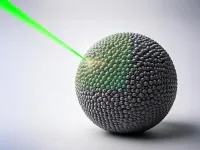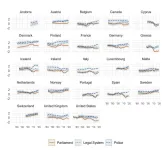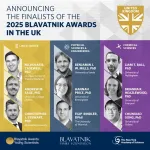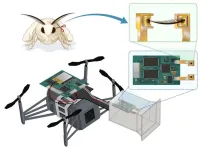(Press-News.org) UNIVERSITY PARK, Pa. — There is a big problem with quantum technology — it’s tiny. The distinctive properties that exist at the subatomic scale usually disappear at macroscopic scales, making it difficult to harness their superior sensing and communication capabilities for real-world applications, like optical systems and advanced computing. Now, however, an international team led by physicists at Penn State and Columbia University has developed a novel approach to maintain special quantum characteristics, even in three-dimensional (3D) materials.
The researchers published their findings today (Feb. 19) in Nature Materials.
“Although the functionalities displayed by two dimensional (2D) materials are vast and their potential is revolutionary, maintaining their superior properties beyond the 2D limit remains a formidable challenge,” said first author Yinming Shao, assistant professor of physics at Penn State, explaining that such materials are typically crystals that are only one atom thick and can be applied in a variety of fashions, including for flexible electronics, energy storage and quantum technologies. “Realization, understanding and control of nanoscale confinement are, thus, crucial for both exploration of quantum physics and future quantum technologies.”
The team examined quasiparticles known as excitons, which have unique optical properties and can carry energy without an electrical charge, in a semiconductor material. Semiconductors — which are ubiquitous across computers, phones and other electronics — conduct electricity under certain conditions and inhibit it under others. Excitons are produced when light hits a semiconductor, energizing an electron to jump to the next energy level. The resulting excited electron and the hole it left are jointly referred to as an exciton. Excitons occur homogenously across typical 3D semiconductors, like silicon.
“But the binding energy for the excitons in bulk materials like silicon is usually small, meaning it’s not very stable and it’s not easy to observe,” Shao said, explaining that excitons are most stable and exhibit superior properties only in 2D monolayers.
The conventional method for preparing 2D materials was developed in 2004 and led to the discovery of graphene, the single layer of carbon that is highly conductive and stronger than steel. The process is simple, but labor intensive, as each layer must be exfoliated from a bulk crystal by applying a piece of sticky tape and peeling it off.
In this thin, 2D state, excitons can carry energy without charge, as well as emit light when its electron and hole recombine, which Shao said is useful for advanced optical applications. To preserve those properties in materials large enough for such applications, however, researchers would need to produce a huge number of layers.
To do this without peeling and stacking each layer by hand, the researchers turned to another aspect of physics: magnetism. Specifically, they focused on chromium sulfide bromide (CrSBr), a layered magnetic semiconductor that co-author Xavier Roy, professor of chemistry at Columbia University, has researched extensively and further developed since 2020.
At room temperature, CrSBr acts as a normal semiconductor just like silicon. Cooling CrSBr down, to around -223 degrees Fahrenheit, brings it to a ground state, or the state of lowest energy. This transforms it into an antiferromagnetic system, in which the magnetic moments — usually referred to as “spin” — of the system’s particles align in a regular, repeating pattern. Specifically for CrSBr, this antiferromagnetic ordering ensures that each layer alternates its magnetic alignment, effectively canceling out a magnetic moment and rendering the material insensitive to external magnetic forces. As a result, excitons tend to stay in the layer with the same spin, rather than hooping to the neighboring layers with the opposite spins. Like cars on alternating one-way streets, these established boundaries keep excitons confined to the layer with which they share the same spin directions.
“This is an effective approach to create a single layer of atomic material without exfoliating it out, while still preserving a sharp interface,” Shao said. “This means we could achieve the same behavior of confined excitons demonstrated in 2D materials in a bulk material.”
Using optical spectroscopy techniques, theoretical modeling and calculation, the researchers determined that this magnetic confinement held firm no matter how many layers were in the system and no matter which layer they confined, including surface layers.
“We did a lot of work to check that this actually holds, and it does,” Shao said.
Shao’s team’s finding was corroborated by another research group out of Germany — Florian Dirnberger and Alexey Chernikov from TUD Dresden University of Technology —who were investigating the same quirk of magnetic semiconductors. The two groups decided to compare notes, Shao said, and found that they all had come to the same conclusion.
“Our data lines up really well, which is remarkable because we used two different crystal materials in different labs,” Shao said. “Our results are in agreement with each other and align well with theoretical predictions, so we wrote this joint paper.”
The aligned result came from harnessing the behaviors of magnetism, Van der Waals interactions and excitons, according to Shao, to achieve quantum confinement with potential applications for advancing optical systems and quantum technologies.
“The marriage of these different aspects of physics was a crucial aspect of this discovery,” Shao said.
Shao completed his doctorate and a postdoctoral fellowship at Columbia University. Other contributors are Siyuan Qiu, Evan J. Telford, Brian S.Y. Kim, Francesco L. Ruta, Andrew J. Mills, Daniel G. Chica, Avalon H. Dismukes, Michael E. Ziebel, Yiping Wang, Jeongheon Choe, Youn Jue Bae, Xiaoyang Zhu, Xavier Roy and D. N. Basov, Columbia University; Florian Dirnberger, Sophia Terres and Alexey Chernikov, TUD Dresden University of Technology, Germany; Swagata Acharya and Rupert Huber, National Renewable Energy Laboratory, United States; Dimitar Pashov, King’s College London, United Kingdom; Mikhail I. Katsnelson, Radboud University, Netherlands; Kseniia Mosina and Mark van Schilfgaarde, University of Chemistry and Technology Prague, Czech Republic; and Zdenek Sofer, University of Regensburg, Germany. Dirnberger is also affiliated with the Technical University of Munich. Kim is also affiliated with the University of Arizona. Mills is also affiliated with the Flatiron Institute. A full list of the authors and their affiliations may be found in the paper.
The U.S. Department of Energy, the European Research Council, the U.S National Science Foundation, the Würzburg-Dresden Cluster of Excellence on Complexity and Topology in Quantum Matter and the Emmy Noether Program supported this work.
END
Magnetic semiconductor preserves 2D quantum properties in 3D material
2025-02-19
ELSE PRESS RELEASES FROM THIS DATE:
Magnetic switch traps quantum information carriers in one dimension
2025-02-19
Illustration
A quantum "miracle material" could support magnetic switching, a team of researchers at the University of Regensburg and University of Michigan has shown.
This recently discovered capability could help enable applications in quantum computing, sensing and more. While earlier studies identified that quantum entities called excitons are sometimes effectively confined to a single line within the material chromium sulfide bromide, the new research provides a ...
Using light to activate treatments in the right place
2025-02-19
Acting in the right place at the right time is the key to effective medical treatment with minimal side effects. However, this feat remains difficult to achieve. Biologists and chemists at the University of Geneva (UNIGE) have succeeded in developing a tool that controls the location at which a molecule is activated by a simple pulse of light lasting only a few seconds. Tested on a protein essential for cell division, this system could be applied to other molecules. The potential applications are vast, both in basic research and in improving ...
Democracy in crisis: Trust in democratic institutions declining around the world
2025-02-19
New research from the University of Southampton has found that trust in representative institutions, such as parliaments, governments and political parties, has been declining in democratic countries around the world.
The study, published in The British Journal of Political Science, presents the largest and most comprehensive analysis of trends in political trust worldwide to date. It brings together results from 3,377 surveys covering 143 countries between 1958 and 2019, representing over five million survey respondents.
Whereas trust in representative institutions is generally in decline, trust in non-representative institutions ...
Finalists announced for the 2025 UK Blavatnik Awards for Young Scientists
2025-02-19
19 February 2025 – London – The Blavatnik Family Foundation and The New York Academy of Sciences today announced the Finalists for the eighth Blavatnik Awards for Young Scientists in the United Kingdom. The Awards recognise scientific advances by UK researchers across Life Sciences, Chemical Sciences, and Physical Sciences & Engineering.
On Wednesday, 4 March, Professor Shitij Kapur, FMedSci, Vice-Chancellor & President, King’s College London, will announce the three 2025 Laureates at a gala dinner and awards ceremony. The three Laureates will each receive an unrestricted award of £100,000 (US$126,000). ...
Bio-hybrid drone uses silkworm moth antennae to navigate using smell
2025-02-19
Conventional drones use visual sensors for navigation. However, environmental conditions like dampness, low light, and dust can hinder their effectiveness, limiting their use in disaster-stricken areas. Researchers from Japan have developed a novel bio-hybrid drone by combining robotic elements with odor-sensing antennae from silkworm moths. Their innovation, which integrates the agility and precision of robots with biological sensory mechanisms, can enhance the applicability of drones in navigation, gas sensing, and disaster response.
Technological advances have led to the development of drones with diverse applications, ...
Do seizures in newborns increase children’s risk of developing epilepsy?
2025-02-19
Seizures in newborns are one of the most frequent acute neurological conditions among infants admitted to neonatal care units. A study published in Developmental Medicine & Child Neurology indicates that newborns experiencing such neonatal seizures face an elevated risk of developing epilepsy.
For the study, investigators analyzed data on all children born in Denmark between 1997 and 2018, with the goal of comparing the risk of epilepsy in children with and without neonatal seizures.
Among 1,294,377 children, the researchers identified 1,998 who experienced neonatal seizures. The cumulative risk of epilepsy was 20.4% among children with neonatal seizures compared with 1.15% among children ...
Does the brain produce estrogen to control appetite?
2025-02-19
Although a woman’s ovaries produce the most estrogen, various types of estrogen are also synthesized throughout different tissues in the body, including the brain’s neurons. New research in The FEBS Journal indicates that such neuroestrogens help suppress appetite.
Knowing that the enzyme aromatase is important for the production of estrogens, investigators depleted or knocked out the gene encoding aromatase in mice, so that the animals were unable to synthesize estrogens in a systemic or body-wide manner. These mice demonstrated increased food intake and body weight compared with their aromatase-expressing counterparts. Restoring aromatase expression specifically ...
Would the prohibition of menthol cigarettes cause more harm than good?
2025-02-19
New research published in Health Economics indicates that a national prohibition of menthol cigarettes in the United States could increase the number of people who attempt to quit smoking but also support an illegal menthol cigarette market.
For the research, 639 adult menthol smokers made hypothetical choices between menthol and non-menthol cigarettes, menthol and non-menthol e-cigarettes, and attempting to quit. Participants were presented with situations where menthol cigarettes and menthol e-cigarettes were described as either legal, prohibited but available under-the-counter and online from retailers who continue ...
What are the benefits and harms of aggressive blood pressure lowering in older adults with different characteristics?
2025-02-19
Results from the Systolic Blood Pressure Intervention Trial (SPRINT) have supported lower blood pressure targets among community-dwelling older adults with hypertension to reduce the risk of cardiovascular disease and early death, but intensive blood pressure lowering can also increase risks of developing acute kidney injury and experiencing dangerously low blood pressure. A recent analysis in the Journal of the American Geriatrics Society looked closely at the benefits and harms of intensive blood pressure lowering in patients with different characteristics.
The analysis found that nearly all older adults in SPRINT had a positive ...
Why is Japanese knotweed so highly invasive?
2025-02-19
Research published in New Phytologist provides insights into why the invasive plant Japanese knotweed is so successful at outcompeting native plants.
Japanese knotweed (Reynoutria japonica), which is native to eastern Asia and is a highly invasive plant species across Europe and North America, is known to damage infrastructure and ecosystems. By comparing growth and reproduction traits of introduced plants with native plants, investigators discovered that introduced plants had gained the ability to reproduce faster by clonal propagation, a method ...



